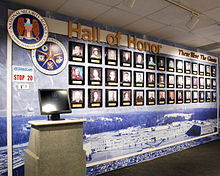Herbert Yardley
Herbert Osborne Yardley (born April 13, 1889 in Worthington , Indiana , † August 7, 1958 ) was an American cryptologist .
Yardley was the son of a station master and telegraph operator on the railroad . He broke off his studies at the University of Chicago to work again in his hometown of Worthington as a telegraphist and entered the civil service in 1912, where he initially worked as a telegraphist and coder in the Foreign Office . In the First World War he served as a reserve officer cryptographer in the US expeditionary force in France . He managed to decipher his own US-American codes , about which he wrote a memorandum in May 1916 . At the same time he convinced his superiors to set up a separate department for the cryptanalysis of foreign encryption , the MI-8 department of the Signal Corps , which he headed from June 1917. After the war he continued this work in the Cipher Bureau (called Black Chamber ) in New York City on behalf of the State Department and the US Army. Their main task was to decipher the Japanese codes, which Yardley managed after a year. The leap in information acquired in this way paid off in particular in 1921/22 during the Washington negotiations to limit the warship fleets of both sides (Washington Naval Conference).
In October 1929, the US Secretary of State Henry L. Stimson closed the Cipher Bureau ( gentlemen do not read other people's mail , gentlemen do not read each other's mail ). Yardley had previously provoked him by saying that he was able to read all the mail from the Vatican . Yardley then wrote his memoirs in the 1931 book The American Black Chamber , which became a bestseller, not only in the United States, but also in Japan, for example. Since he also made foreign governments aware of weaknesses in their encryption mechanisms, he aroused the displeasure of the US government, which could not prosecute him legally, but would no longer work with him in the future. From 1938 to 1940 he worked for the Chinese , whom he helped to decipher Japanese codes (about which he wrote the book The Chinese Black Chamber , which only appeared in 1983), and in 1941 briefly for the Canadian government, for which he had a cryptographic department at the National Research Council established. But then he had to go under pressure from the US government.
Yardley then wrote three detective and spy novels (The Blonde Countess, Red Sun of Nippon, Crows Are Black Everywhere), was a screenwriter and technical advisor for films, and wrote a bestseller on poker ( Education of a Poker Player , 1957).
In 1999 he was inducted into the Hall of Honor of the NSA ( National Security Agency ).
literature
- David Kahn : The Code Breakers - The Story of Secret Writing . Macmillan USA, Reissue 1974, ISBN 0-02-560460-0
- David Kahn: The Reader of Gentlemen's Mail: Herbert O. Yardley and the Birth of American Codebreaking , Yale University Press, 2004.
| personal data | |
|---|---|
| SURNAME | Yardley, Herbert |
| ALTERNATIVE NAMES | Yardley, Herbert Osborne (full name) |
| BRIEF DESCRIPTION | American cryptologist |
| DATE OF BIRTH | April 13, 1889 |
| PLACE OF BIRTH | Worthington, Indiana |
| DATE OF DEATH | 7th August 1958 |


